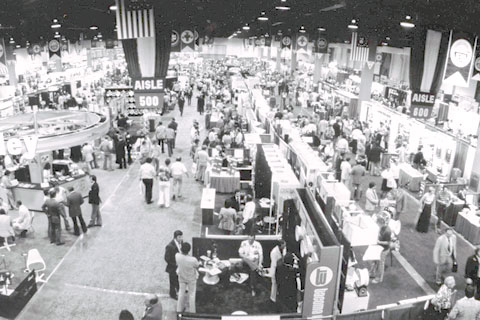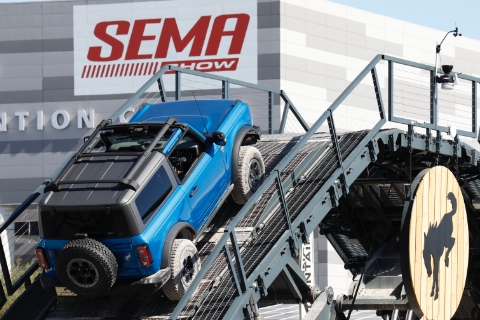SEMA News—March 2014
BUSINESS
By Mike Imlay
Racing Update
Some Hot Segments to Watch
| |
“The recession has been tough on racing,” said John Kilroy, vice president and general manager of Performance Racing Industry (PRI). “No one is really pounding his chest at the moment, but at least it seems that we’re back to ‘business as usual.’ There’s a strength returning to auto racing as the economy strengthens. Every year that we get away from 2009, things are better.”
Kilroy noted that the floor of the most recent PRI trade show in December buzzed with an extremely optimistic vibe, “as if the dread of recessionary times is behind us.”
“I believe that all of auto racing is spending a lot of time and creative energy right now on keeping racers racing, attracting the next generation into the sport and getting new fans into the grandstands to enjoy the thrills of this sport,” he said.
Kilroy identified several segments that are especially on the rebound: dirt-track racing, vintage/historics, drag racing, off-road racing and the National Auto Sports Association (NASA) series. According to Kilroy, dirt-track racing actually remained fairly robust throughout the economic downturn, mainly because it tended to be easier on equipment and allowed grassroots racers to stretch their budgets to continue racing.
“Dirt Late Models are very strong,” he observed. “It’s great fun to race them, and there’s widespread fan appeal. This form of racing has had momentum for years and continues to have momentum. The POWRi series has a formula that’s working really well to build their car counts dramatically in midget racing. Short dirt tracks and the promise of two races on the weekend have been very attractive.”
In addition, this type of racing is also growing in fan appeal and contingency support from the industry. In fact, Kilroy emphasized that there’s a lot of fun to be had per dollar spent in dirt-track racing. Plus, the dirt-racing formula allows a wider spectrum of the field to be truly competitive and “hunt for the win.” He noted that International Motor Contest Association (IMCA) modifieds—whose bodies are hybrids of stock and open-wheel cars—offer similar opportunities.
“The POWRi series has created a very attractive formula for grassroots dirt-track racers that offers a level of affordability while also offering the ability for teams on more of a budget to be competitive with high-dollar teams,” Kilroy explained. “The IMCA modified series offers the regular working man a terrific arena in which to go racing.”
Vintage Auto Racing
Another segment that aftermarket manufacturers and retailers may want to pay special attention to is vintage auto racing. The Vintage Auto Racing Association (VARA), which was founded in 1973 and is now the largest vintage racing membership organization on the West Coast, exemplifies the spirit of this motorsports segment. According to VARA General Manager Jeanette Bourke, its race fields are made up of production and sports cars dating from 1986 all the way back to 1916, and the association also acts as an umbrella for a number of other marquee car events.
“We range from budget racers all the way up to arrive-and-drive racers,” Bourke said. “Besides the University [racing school] we do, which is open to street cars and race cars, we do five to six race events per year. The fun part, where we differ from NASCAR and oval racing, is that your entry gets you into the pits as a spectator. You’re actually there, right up close, and our drivers like to be asked about their cars. You can see our drivers and their mechanics working on the cars at arms length. The beauty about us is that the sort of history you see parked at the Petersen [Automotive Museum] is out on the track.”
| ||
“For instance, they might buy a BMW 2002 or a Datsun 510, which they can work on themselves and for which parts are available,” she noted. “When people come out, they see $10,000 race cars right alongside bottom-budget cars.”
What’s more, because VARA is a nonprofit, membership-driven body, it’s able to keep costs down for racers as well as fans.
“I think that’s why we’re doing so well,” Bourke said. “It’s a family atmosphere.”
Bourke added that it’s also an ideal venue for manufacturers and retailers to mingle and connect with racers and enthusiasts who are hungering for product. The racers in particular, she said, are extremely eager to talk parts with aftermarket representatives.
Kilroy agreed that vintage racing is always “a good market for contemporary components, as they tend to put brand-new parts on the old race cars. Vintage racing tends to be a more relaxed, gentlemen’s kind of racing. The car counts have remained strong, and that segment is spending the money.”
NHRA Drag Racing
In the realm of drag racing, the NHRA has been especially exemplary in growing its sport, embarking on numerous initiatives recently to increase star building, bolster member track growth and relationships and promote further diversity, multi-culturalism and youth involvement. The racing organization also plans renewed pushes into television and radio advertising along with a broader social-media presence for 2014.
“We were very excited by the way the 2013 season ended from an event-ticket standpoint,” said Glen Cromwell, NHRA vice president of sales and marketing. “We were very happy with attendance, which was strong, along with the outcomes of the championships. Of course, we want to keep that momentum going for 2014. Just rolling into ticket sales, we are excited and seeing an uptick in our renewals for 2014. I won’t say it’s huge, because the economy is still a question for many people. But we are seeing growth.”
Cromwell said that car counts are also looking bullish for the coming year. In addition, the NHRA hopes to continue to build on its successful marketing strategies of recent years in an effort to attract younger fans.
“Our programs at the national event level have seen over a 60% increase in youth, so we’re pretty excited about that,” he said, adding that the organization is also proud of its work in attracting female and minority participants and fans.
“It’s a great story,” he said. “Diversity is a big part of who we are.”
Cromwell pointed out that the NHRA offers numerous marketing opportunities for aftermarket businesses of all types and sizes, from full-scale event sponsorships and contingency programs for larger companies down to local track programs suitable for smaller businesses and retailers.
“They can tap in at all levels,” he explained. “Of course, we have our Mello Yello series and divisional events, and you can also get involved with our 12 youth and education programs. And let’s not forget that we have more than 130 member tracks that have programs across the United States.”
Off-Road Competition
| |
Considered by many to be the “granddaddy of championship desert racing,” SCORE International epitomizes the enthusiasm and growth of off-road motorsports. In 2012, the sanctioning body was acquired by racer Roger Norman from Sal Fish, who had been the face of SCORE for 39 years after the organization was originally founded by Mickey Thompson in 1973.
“To be in this position as the owner and head of the world’s most prestigious desert-racing organization is both an honor and a privilege,” said Norman, who himself won the 2008 Tecate SCORE Baja 1000 in the Trophy Truck division. “I have a vision and passion for SCORE and working closely with our staff, our sponsors and our racers, I am confident that what we have done and are doing has heralded the start of a dynamic new SCORE International.”
Perhaps the biggest news from the organization is that it just concluded a new three-year contract with the Mexican government to bring the popular Tecate SCORE San Felipe 250 back to that Sea of Cortez fishing village 125 miles south of the United States.
“It’s wonderful for SCORE and our sport to continue having this type of proactive support and sponsorship from the Mexican government, which does so much to enhance the quality of our events in Baja California,” said Norman.
Over the years, SCORE has brought tremendous prestige to off-road racing, with a plethora of celebrity drivers, a long list of endemic and non-endemic sponsors and major mainstream media coverage, including television broadcasts by ABC, NBC and ESPN. Recent telecasts have topped 1 million viewers for each race event.
Executive Summary:
| ||
Off-road competition remains a vibrant sector for the aftermarket, regardless of whether it’s desert racing or closed-course racing.
“There are segments of off-road racing that offer a big space for innovating technically, and there is some seriously advanced technology on a race vehicle like a Trophy Truck,” observed Kilroy. “The budgets are strong, and the car counts are strong, so there’s lot of fun to be had in the R&D process, and there is certainly a big opportunity for sales of hardcore racing equipment.”
Finally, according to Kilroy, NASA racing has also become one of the fastest-growing series in recent years. Relatively new on the scene, the association was formed in 1991 and concentrates on programs that allow both race cars and high-performance street vehicles to compete in a safe and controlled environment. Racing includes High Performance Driving Events, Rally Sport, Time Trial and NASA-X (a version of autocross), among other events.
“There’s a great connection between this road-racing sanctioning body and racers,” said Kilroy. “They are doing an excellent job of keeping racers racing. NASA offers a matrix of fun racing, affordability and easy access that has proved very popular.”
Large OEs and aftermarket manufacturers are increasingly stepping up support of this motorsports segment. For example, NASA announced an official, organization-wide Toyo Tires contingency program this past January that is available to all competitors immediately. With an overall value of $10 million, it ranks as one of racing’s most lucrative programs. Last November, oil manufacturer Royal Purple also provided what NASA officials hailed as a generous E3 contingency program for the 2013 NASA 25 Hours of Thunderill presented by the USAF.
“The better-performing segments of auto racing generate a real positive sense that health is returning to the industry after the beating it took in the early years of the recession,” Kilroy said. “We can see how the thrills of the sport attract both participants and fans, as it always has. In other words, the formula that’s worked for decades continues to work to drive this industry into the future.”
Sources
National Hot Rod Association (NHRA) National Auto Sport Association (NASA) Performance Racing Industry (PRI) | SCORE International Vintage Auto Racing Association (VARA)
| |











